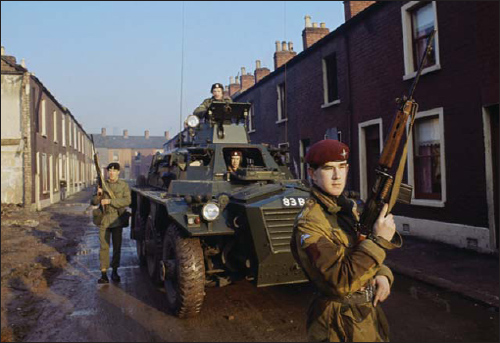
As the sovereign state responsible for security in Northern Ireland, Britain has always sought to portray its role in the conflict as benign, even going to the extent of declaring itself a ‘third party’ or ‘umpire’. Despite protestations to the contrary, however, Republicans and nationalists regard Britain as one of the principal parties to the conflict. Far from being a ‘neutral arbiter’ it was motivated mainly by constitutional interests and by the overwhelming desire to insulate itself from what became, in leading strategic theorist M. L. R. Smith’s words, ‘the most destabilizing issue in British politics for a generation’. Keeping the Irish conflict ‘at arm’s length’ had been the British government’s most consistent policy since the formation of Northern Ireland.
It was unsurprising, then, that the prospect of intervening in the province caused considerable consternation within government circles. The Home Secretary, James Callaghan, hoped that the Unionist administration would not need to invoke the ‘military aid to the civil power’ provision, but was perceptive enough to commission the Ministry of Defence (MoD) to draw up contingency plans for deploying British troops over the Christmas leave period in 1968–69.

2nd Lieutenant David Brough of 1st Battalion, The Parachute Regiment, on patrol in Cupar Street, Belfast, in August 1969, armed with the standard self-loading rifle, or SLR. The British Army’s arrival on the streets of Northern Ireland brought with it Saracen armoured personnel carriers, which were to become a familiar sight. (IWM TR 32986)
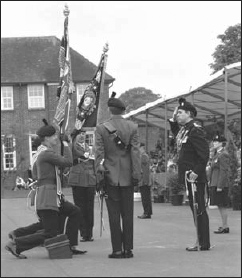
HRH Prince Andrew, Honorary Colonel of the UDR/Royal Irish Regiment, presents new colours to 3rd Battalion, The Royal Irish Regiment, on 17 June 2000. (IWM HU 98341)
British troops had been deployed on Irish soil before, of course, finally departing the south in the aftermath of the Anglo-Irish War of 1919–21. They had been headquartered in the Curragh near Dublin; after the partitioning of Ireland in 1920 the Army kept a peacetime garrison of several thousand troops in Northern Ireland. That figure swelled from 4,000 to 6,000 upon the outbreak of serious intercommunal violence in mid-August 1969; numbers rose again to 11,243 within a year. Based in Lisburn, Headquarters Northern Ireland (HQNI) became the operational hub for all military operations in the province. In August 1969, 39 (Infantry) Brigade was established, responsible for Belfast and the eastern part of the province; 8 (Infantry) Brigade took over operational responsibility for the north and west of the province in January 1970, and 3 (Infantry) Brigade oversaw operations in Northern Ireland’s southern region.
Northern Ireland presented a wholly novel challenge for British troops. Reflecting on his time as Commanding Officer of 3rd Battalion, The Parachute Regiment (3 Para), in South Armagh during the 1970s, Peter Morton observed how ‘soldiering in Northern Ireland is certainly not about aggression, nor fatalism, and indeed many would argue that it is not really soldiering at all’. The British Army tended to rely on tried-and-tested methods of dealing with civil unrest and violence. The troops who were initially deployed to Derry/Londonderry and Belfast advanced to trouble spots in box formation, a type of colonial policing technique that afforded troops the opportunity to outmanoeuvre rioters and stop violence before it had a chance to escalate.
The Army arrived on the streets, therefore, with limited knowledge of the Troubles facing them, and they depended disproportionately on the experience of members of both the RUC and (from 1970) the new, locally recruited part-time Ulster Defence Regiment (UDR), who were more familiar with the nuances underpinning the conflict. As one former Royal Engineers soldier remarked, ‘They were there all the time. It was their home. We were just visitors.’ The RUC had 3,000 officers in 1969 and could call on a further 1,500 members of the Ulster Special Constabulary (USC), known as the ‘B’ Specials, in dire situations. Although they were routinely armed, there were few violent incidents. However, as their reaction to the trouble in Divis Street in 1964 had demonstrated, they had little public-order training. In the case of the USC there was a general lack of discipline, particularly among the reservist ‘C’ Specials. Following the 1969 Hunt Report’s recommendations, the USC was abolished and replaced by the UDR.
Despite the military failure of its border campaign, the IRA extended its insurgency to the realm of political subversion and agitation as a means of preparing the ground for future action against the north. Many of those who later joined the IRA after street disturbances would contend that they were propelled into paramilitary ranks because of the context of the time, which made ‘ordinary people’ do ‘extraordinary things’. In an interview with the author, one former IRA member said he joined its ranks when state opposition to civil rights marches cut off the means of peacefully registering protest. ‘We tried the force of argument; it didn’t work so … it had to be the argument of force.’ This was a view shared by a growing number of men and women who recognized that in order to bring about ‘a fairer society’, things had to be ‘deconstructed’. For the former IRA member, ‘the only vehicle that could possibly bring that about was the IRA’.
The IRA was reborn out of the ashes of Bombay Street, a small, close-knit Catholic community in the shadow of the Clonard Monastery in West Belfast, which was razed to the ground during severe rioting in August 1969. While before there had been a handful of IRA members across Belfast, what structure there was had little command-and-control capability, and weapons were practically non-existent. By the end of the year the IRA had split into two organizations and had mushroomed in size to almost 1,000 members. Following a meeting of the ruling IRA Army Council, dissidents in favour of a more proactive defence of beleaguered Catholic communities made their position known through the media. At a Sinn Féin/IRA Ard Feis (main meeting) in January 1970 the Republican movement formally split. Those who remained behind became known as the Officials and those dissidents who left became known as the Provisionals.
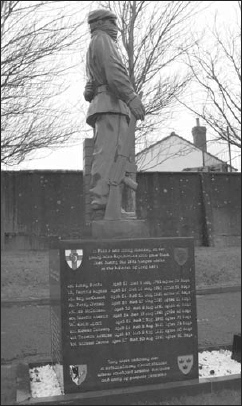
The IRA drew on history to justify its resort to ‘armed struggle’. This memorial in Derry/Londonderry City Cemetery commemorates the 1981 hunger strikers. (Aaron Edwards)
In walking away from existing IRA structures, the Provisionals faced the momentous task of building up a new underground organization. According to evidence he gave at the Saville Inquiry into Bloody Sunday, Martin McGuinness estimated that the Provisional IRA in the city of Derry/Londonderry was a small unit, with only 40–50 active members in 1970–71. In an interview with the author, a former leading member of the organization’s Belfast Brigade, Tommy Gorman, recalled that although the Provisionals attracted new recruits, for every 300 members in a company, only about five were active:
It was in a pretty bad state. I think in Divis Street that night [1969] there were a couple of short arms and a sub-machine gun. But … at that time it was moribund. And it was in the influx of new recruits and all these older people who had been retired and had gone out back to their farms or something and had suddenly reappeared again and gave us some sort of structure. And it was based on the British Army [structure]. You had companies, battalions and brigades. And companies were based on geographical areas so security was pretty lax. And with the influx of so many new volunteers anybody can sneak in with the rush.


Networks of police, Army and security services informers – or ‘touts’ as they became known in local parlance – soon penetrated the IRA from top to bottom. This became one of the main reasons why the British state was later able to inflict a strategic defeat on the organization.
IRA members came from a variety of backgrounds, though most of the raw recruits, like Gorman, came from working-class areas. Few, if any, had prior military training and the majority joined the IRA following a brush with street violence in their local neighbourhoods. Several were also hardened criminals, who found themselves caught up in Republican militancy because of their expertise in procuring funds through illicit means. As J. Bowyer Bell observed in his seminal study on the IRA, The Secret Army, ‘[f]ew Irish rebels are as skilled as the professional soldier – although the protraction of the struggle has meant a rise in standards, standards constantly eroded by losses, lack of training, the needs of the moment, and the failure of corporate memory’. Nonetheless, the IRA was accomplished at portraying its membership as being ‘principled soldiers of Ireland’. In its internal Code of Conduct, known to rank-and-file members as the Green Book, it warned that ‘[a]ny Volunteer who brings the Army into disrepute by his/her behaviour may be guilty of a breach of his/her duties and responsibilities as a Volunteer in Óglaigh na hÉireann and may be dismissed’.
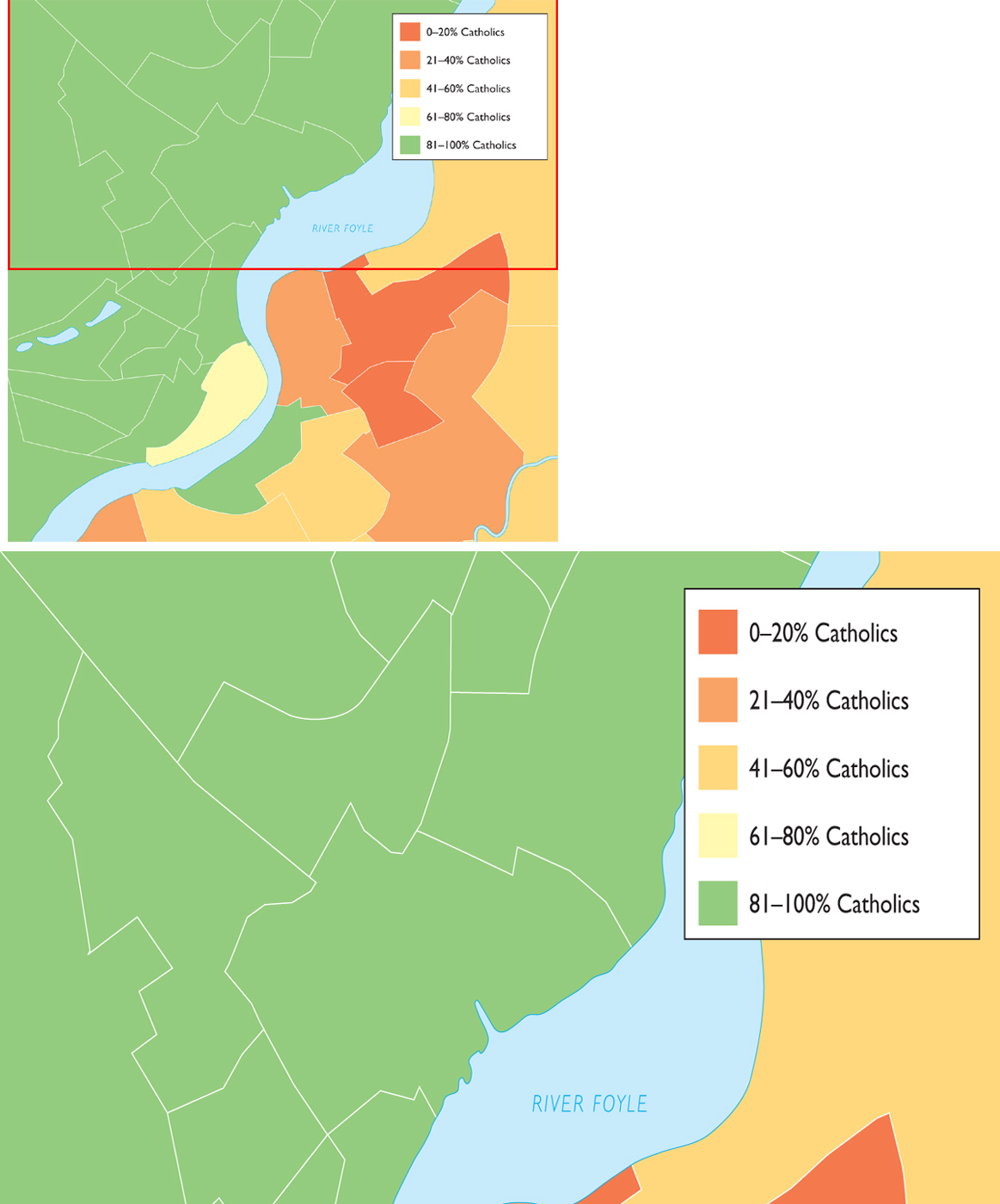

In terms of weapons and explosives the IRA began as a poorly equipped and ill-disciplined organization. A Provisional IRA member interviewed by the Saville Inquiry recalled how
… [t]he weaponry was very ancient to say the least. The Creggan and Bogside units would each have had something like a Thompson [submachine gun], an M1 Carbine, a couple of .303s. There may have been a couple of revolvers as well.
Despite these drawbacks, the IRA would soon emerge as one of the world’s most sophisticated guerrilla movements. Remarkably, this transformation would take place within a matter of months.
Loyalist paramilitarism was a small-scale affair at the outset of the Troubles. It coalesced mainly around the secretive UVF, re-established in November 1965. By 1971, Loyalist paramilitary ranks had ballooned with the formation of the Ulster Defence Association (UDA). The UDA was a huge, unwieldy organization, boasting over 40,000 members by the mid-1970s. Some of its more militant members established an armed wing, the Ulster Freedom Fighters, which killed approximately 259 people between 1971 and 2002. Unionist politicians were worried at the prospect of vigilantism; others, like Stormont Minister for Home Affairs Bill Craig, sought to harness paramilitary muscle for their own political purposes. Protestant militancy soon emerged as a formidable force in Northern Ireland politics.
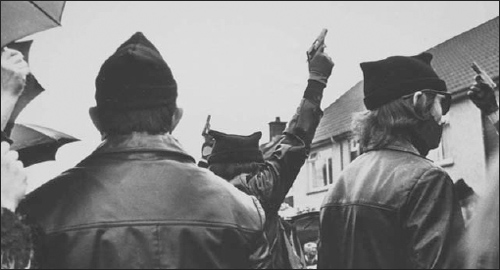
The Ulster Volunteer Force emerged in 1965 to counter the perceived threat posed by the IRA. It murdered almost 500 people during the Troubles. (Fred Hoare)
The UVF portrayed itself as a ‘counterterrorist outfit’ during the Troubles. Indeed many of its key members had previous military experience in the British armed forces, with its first commander Augustus ‘Gusty’ Spence having served in anti-EOKA operations in Cyprus in the late 1950s. One former member had even served in the ranks of the Special Air Service, fighting communist terrorists in Malaya. In the early 1970s several UVF members also belonged to the Territorial Army. It was not long before the UVF began to organize itself along British Army lines. As one former leader revealed in an interview with the author:
The UVF was formed on a British brigade structure of three battalions, Belfast, Mid Ulster and East Antrim. The idea for the East Antrim Battalion [was that] people believed that it wasn’t about the interfaces, it was about the constitution, the future of Northern Ireland, so the UVF was not formed to deal with interfaces, it was formed because they believed there was a sell out, there was a rebellion which had to be stopped. Whether you were from the Shankill or East Antrim you had the one enemy – the IRA. Indeed the nationalist community [more broadly were considered the enemy], as most UVF volunteers didn’t distinguish between the IRA and those they fought for.
The UVF was a ruthless terrorist organization, responsible for approximately 458 deaths between 1966 and 2002: 84 per cent of its victims were civilians, 10 per cent were other Loyalists, 5 per cent were Republicans and 1 per cent were Security Forces personnel. The Loyalists were to prove as ruthless in their violence as their Republican enemies.